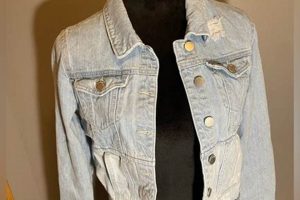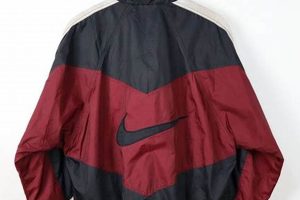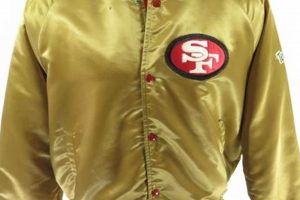Garments traditionally worn by high school and college students to represent school pride and achievement in athletics or academics, these jackets represent a distinct era of personalized fashion. They are characterized by a wool body, leather sleeves, and chenille patches displaying the wearer’s initial and accomplishments.
These garments hold historical significance, reflecting the values and styles of past generations. They offer a tangible connection to the history of educational institutions and youth culture. Furthermore, they can represent individuality, a status symbol, a fashion statement, and a piece of wearable history.
The following sections will delve into the key features, identification, care, and collecting of these unique and highly valued pieces of apparel. This exploration will provide a deeper understanding of their enduring appeal and cultural impact.
Tips for Assessing and Maintaining Vintage Varsity Letterman Jackets
Proper care and evaluation are essential when dealing with these vintage items. The following guidelines offer practical advice for collectors and enthusiasts.
Tip 1: Examine Material Composition: Verify the composition of the jacket’s body (typically wool) and sleeves (usually leather). Authentic examples will display high-quality materials appropriate to the era of production.
Tip 2: Inspect Chenille Patch Attachment: Scrutinize the stitching and attachment methods of the chenille patches. Look for secure and well-executed stitching, indicative of quality craftsmanship. Loose or poorly attached patches can devalue the item.
Tip 3: Assess Lining Condition: Evaluate the lining for any signs of damage, such as tears, stains, or excessive wear. A well-preserved lining enhances the jacket’s overall value and longevity.
Tip 4: Check for Original Labeling: Identify the presence of original manufacturer labels or tags. These labels can provide crucial information about the jacket’s origin, production period, and authenticity.
Tip 5: Evaluate Hardware Integrity: Assess the condition of buttons, snaps, and zippers. Ensure that all hardware functions properly and is free from corrosion or damage. Replacement hardware can detract from the jacket’s historical integrity.
Tip 6: Proper Storage: Store the jacket in a cool, dry place away from direct sunlight to prevent fading or damage to the materials. Consider using a padded hanger to maintain its shape.
Tip 7: Professional Cleaning: Seek professional cleaning services specializing in vintage garments. Avoid using harsh chemicals or washing machines, as these can damage the delicate materials.
Applying these tips ensures the preservation and accurate assessment of these historical garments. Following them will protect the jacket’s value and its place as a unique piece of memorabilia.
With a solid understanding of these assessment and maintenance principles, one can confidently navigate the world of these sought-after vintage collectibles.
1. Authenticity
Authenticity, in the context of vintage varsity letterman jackets, determines the garment’s genuine origin and historical accuracy. A jacket lacking verifiable authenticity loses its intrinsic value as a piece of historical memorabilia. Factors contributing to a jacket’s authenticity include verifiable manufacturer’s labels, documented provenance, and consistency with known production techniques and materials of the purported era. Discrepancies in these areas cast doubt on a jacket’s legitimacy.
The implications of inauthenticity are significant. A reproduction, regardless of its quality, does not hold the same cultural or monetary value as a genuine vintage item. For example, a jacket claimed to be from a specific championship-winning team but lacking verifiable team records or player identification is deemed inauthentic. Understanding authenticity enables collectors and enthusiasts to distinguish between genuine articles and recreations, protecting their investments and preserving historical integrity.
Ensuring authenticity requires careful examination and research. Consultation with vintage apparel experts and access to institutional archives are essential tools. Successfully verifying a jacket’s origin confirms its place within a historical narrative, solidifying its value and appeal. Challenges remain in combating increasingly sophisticated forgeries, highlighting the need for continued vigilance and informed assessment. Ultimately, authenticity defines the essence and desirability of this vintage apparel.
2. Condition
In the realm of vintage varsity letterman jackets, condition serves as a primary determinant of value and desirability. The state of preservation directly reflects the jacket’s history, usage, and subsequent care. Discrepancies in condition influence collector interest and market valuation.
- Fabric Integrity
The wool body and leather sleeves are susceptible to wear, fading, and damage. Tears, stains, and significant material degradation diminish a jacket’s value. Original fabric integrity signifies responsible care and preservation. For example, a jacket with minimal moth damage to the wool body retains higher value than one with extensive damage.
- Chenille Patch Preservation
Chenille patches, often representing athletic achievements or school affiliations, are prone to deterioration. Faded colors, detached threads, or missing patches detract from the jacket’s aesthetic and historical appeal. A jacket with vibrant, intact patches provides enhanced visual appeal and authenticity.
- Lining Status
The internal lining of a vintage jacket provides structural support and comfort. Tears, stains, or fraying within the lining can compromise the garment’s integrity and wearer experience. A well-maintained lining indicates overall responsible care and extends the jacket’s lifespan.
- Hardware Condition
Buttons, snaps, and zippers are essential components that often exhibit signs of aging or wear. Corrosion, breakage, or missing hardware negatively impacts functionality and aesthetic value. Original hardware in good working order signifies careful maintenance and elevates the jacket’s desirability.
The interplay of these condition facets collectively influences the value and appeal of vintage varsity letterman jackets. Assessment of each element informs purchase decisions and guides preservation efforts, ensuring these historical garments retain their significance for future generations.
3. Materials
The composition of materials used in these jackets holds paramount importance. It determines their durability, aesthetic appeal, and, ultimately, their value as historical artifacts.
- Wool Composition
The body of these jackets is traditionally constructed from wool. The quality of the wool impacts the garment’s warmth, texture, and resistance to wear. Higher grade wool, such as Melton wool, indicates a premium jacket designed for longevity. Examination of the wool’s weave and fiber quality reveals valuable information about the jacket’s original manufacturing standards.
- Leather Sleeves
Leather sleeves are a distinguishing feature, commonly made from cowhide or horsehide. The type and thickness of the leather affect the jacket’s durability and flexibility. Jackets with supple, well-preserved leather sleeves signify quality materials and attentive care. Distinctions in leather grain and tanning methods further contribute to the jacket’s unique characteristics.
- Chenille Patches
Chenille patches, often crafted from wool or acrylic yarn, serve as emblems of achievement and affiliation. The quality of the chenille yarn and the density of the stitching influence the patch’s visual impact and longevity. Faded or damaged chenille patches detract from the jacket’s overall appeal, highlighting the importance of material preservation.
- Lining Fabrics
The internal lining, typically made from rayon or satin, provides comfort and protection. The choice of lining fabric affects breathability and durability. A well-maintained lining enhances the jacket’s structural integrity and contributes to its overall value. Tears, stains, or disintegration of the lining indicate neglect and diminish the jacket’s desirability.
The careful selection and combination of these materials contribute significantly to the enduring appeal. Identifying and evaluating the materials used in the creation of vintage varsity letterman jackets is essential for collectors seeking authentic and well-preserved examples of this iconic garment. The integrity of these materials directly reflects the jacket’s historical value and aesthetic merit.
4. Customization
Customization is intrinsic to the nature and appeal of vintage varsity letterman jackets. The garment, by design, serves as a canvas for individual achievement and affiliation. Cause and effect are readily apparent: athletic or academic success results in the awarding of a letter, which is then proudly displayed on the jacket. The absence of personalization diminishes a jackets historical narrative and its value as a unique artifact. A blank, unadorned jacket lacks the personal connection that transforms it from mere clothing into a tangible representation of a student’s journey. For example, a jacket emblazoned with a state championship patch and the wearers initials immediately conveys a compelling story of dedication and triumph, thereby increasing its collectibility.
The significance of customization extends beyond mere decoration. Each patch, letter, or emblem represents a specific accomplishment or membership. Consider the practical application for historical research: a jacket’s customization can provide valuable insights into the wearer’s life, the school’s athletic programs, and the social dynamics of the era. A meticulously customized jacket can serve as a primary source document, offering details not found in yearbooks or official records. The presence of specific patches can indicate participation in particular clubs, sports, or academic honors societies, creating a richer understanding of the wearer’s extracurricular activities and academic pursuits.
In summary, customization is not merely an aesthetic element but a fundamental component that defines the essence and historical significance. Challenges in assessing customization include verifying the authenticity of patches and accurately interpreting their meaning. Despite these challenges, understanding the interplay between customization and these jackets enhances the appreciation and preservation of these artifacts. Customization transforms a garment into a unique chronicle of individual accomplishment and institutional history, solidifying the jacket’s enduring appeal.
5. Rarity
Rarity significantly influences the value and desirability of vintage varsity letterman jackets. Scarce jackets, distinguished by unique attributes or historical circumstances, command higher collector interest and market prices. Several factors contribute to a jacket’s scarcity, shaping its status within the collector community.
- Limited Production Runs
Jackets produced in limited quantities, often due to specific team achievements or commemorative events, are considered rare. Small production runs enhance exclusivity and increase demand among collectors. For example, a jacket created for a team that won a national championship with a limited run production is rarer than other jackets.
- Unique Material Combinations
Jackets featuring unusual material combinations or experimental designs represent deviations from standard production practices. Such variations can result in limited availability and increased collector appeal. Jackets with specific type leathers will have limited production for the rarity itself.
- Association with Notable Figures
Jackets previously owned or worn by prominent athletes, coaches, or alumni possess increased rarity due to their historical connection to notable individuals. Provenance linking a jacket to a well-known figure elevates its collectibility. An item once owned by hall of fame athlete could increase the value jacket for its rarity.
- Specific Era or Institutional Affiliation
Jackets originating from historically significant eras or affiliated with now-defunct institutions can be challenging to acquire. The passage of time and institutional closure contribute to scarcity. Example jackets from very old universities will be rare in the current market.
These facets collectively determine the rarity and, consequently, the value of vintage varsity letterman jackets. Collectors actively seek scarce examples, recognizing their unique historical significance and investment potential. Understanding the factors that contribute to rarity informs acquisition strategies and preservation efforts, ensuring the enduring appreciation of these unique garments.
6. Provenance
The verified history of ownership and custody, or provenance, significantly enhances the value and collectibility of vintage varsity letterman jackets. It establishes a direct link between the garment and a specific individual, event, or institution, transforming a piece of apparel into a tangible artifact with historical narrative. The absence of verifiable provenance relegates a jacket to a generic status, diminishing its appeal to serious collectors. Cause and effect are clear: documented provenance translates to increased historical and monetary worth. A jacket with a clear chain of ownership, tracing back to the original wearer or a relevant historical event, gains a premium over an otherwise identical jacket lacking such documentation.
To illustrate, a jacket once worn by a notable athlete, supported by photographic evidence or authenticated family records, commands a higher price than a similar jacket with unknown origins. Similarly, a jacket associated with a historically significant event, such as a championship-winning season or a school’s centennial celebration, gains enhanced value through its documented connection to that event. Practical applications of provenance extend to verifying the authenticity of claimed associations. Expert authentication services, historical archives, and genealogical research play crucial roles in validating the historical accuracy of a jacket’s purported provenance. Scrutinizing manufacturer’s labels, examining stitching patterns, and comparing design elements with known examples from the relevant era contribute to a comprehensive assessment of the jacket’s legitimacy.
In conclusion, provenance serves as a cornerstone in assessing the historical significance and market value of vintage varsity letterman jackets. The verified history of ownership elevates a garment from a simple piece of apparel to a compelling historical artifact. Challenges remain in tracing and authenticating provenance, particularly for older or undocumented pieces. Nonetheless, understanding the importance of provenance enhances appreciation and underscores the need for rigorous historical research and authentication in the realm of vintage collectibles. The documented history is as integral to the jacket’s worth as the material it is made from.
Frequently Asked Questions
The following questions address common inquiries regarding the identification, valuation, and care of vintage varsity letterman jackets.
Question 1: What are the primary indicators of a vintage jacket’s authenticity?
Authenticity is determined by verifiable manufacturer’s labels, consistency of materials with the purported era, documented provenance, and expert evaluation of construction techniques. Discrepancies in these areas may indicate inauthenticity.
Question 2: How does the condition of a vintage varsity letterman jacket affect its market value?
Condition serves as a primary determinant of value. Jackets in excellent condition, with minimal wear, intact patches, and original hardware, command higher prices than those with significant damage or deterioration.
Question 3: Which materials are commonly used in authentic varsity letterman jackets, and what is their significance?
Authentic jackets typically feature a wool body, leather sleeves (cowhide or horsehide), chenille patches (wool or acrylic yarn), and rayon or satin lining. The quality and preservation of these materials directly impact the jacket’s historical and aesthetic value.
Question 4: How does customization, such as patches and lettering, influence the value of a vintage varsity letterman jacket?
Customization enhances historical significance and collectibility. Each patch or emblem represents a specific accomplishment or affiliation, providing insight into the wearer’s history and institutional context.
Question 5: What factors contribute to the rarity of a vintage varsity letterman jacket?
Rarity is influenced by limited production runs, unique material combinations, association with notable figures, and affiliation with historically significant eras or defunct institutions.
Question 6: Why is provenance important, and how is it verified?
Provenance, the documented history of ownership, establishes a direct link to a specific individual or event, increasing the jacket’s historical and monetary worth. Verification involves examining historical records, consulting authentication services, and assessing manufacturer’s labels and construction techniques.
Understanding these key aspects aids in the accurate assessment and preservation of these historically significant garments.
The following section will explore resources available for collectors and enthusiasts.
Conclusion
This exploration has detailed the defining characteristics, evaluation criteria, and historical importance of vintage varsity letterman jackets. Authenticity, condition, materials, customization, rarity, and provenance collectively determine the value and collectibility of these garments. The absence of thorough assessment in these areas can lead to misinformed acquisitions and compromised preservation efforts.
Continued research and meticulous attention to detail remain essential for collectors and historians. The preservation of these jackets ensures that future generations can appreciate their historical significance and unique representation of academic and athletic achievement. Diligence in authentication and care will safeguard their legacy.







